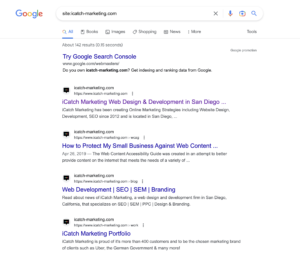So, you have a beautiful website built out for your company, but it’s not gaining organic traffic. This is a common issue with website development. Let’s dive into the top four reasons why your website is not bringing in any visitors, and how to solve these problems.
Technical SEO Issues
Technical SEO (search engine optimization) issues can cause search engines to drop your ranking on the search results page. This refers to any aspects of your website that could have an impact on your website’s indexation, crawlability, and search rankings.
Here are the most common technical SEO issues that we see and how to solve them:
- No HTTPS security: If your website does not have HTTPS security, it will alert users that the site is not secure. This will likely increase your bounce rate, as users will exit your page more often when they see this warning. To fix this, you need an SSL certificate from a Certificate Authority.
- Site Crawl Errors: Broken up into two categories: Site errors and URL errors, these issues can cause problems for search engines to properly crawl your site. Common issues for crawl errors include the usage of a noindex tag. This tag prevents search engines from crawling your site. To fix this, simply remove the tag. Another crawl error could involve access errors to robots.txt. If search robots are unable to access files it creates an “unavailable” error. To fix this, verify that robots.txt is configured correctly.
- URL Crawl Errors: These issues occur when the Googlebot is unable to crawl individual pages due to redirect errors, broken links, and outdated sitemaps. To fix these errors, it is important to verify these errors under Google Search Console to view the pages that are giving these errors. From there you can fix any broken links, correct redirects, configure 404 response codes, generate the robots.txt file, and record the sitemap.
On-Page SEO
- Fixing duplicate and/or truncated title tags: This piece of HTML code indicates to search engines the title of your page which then gets displayed in your browser tab as well as search results and social media. The title tag tells the search engine what your page is about. Having a duplicate or truncated title tag will make it difficult for the search engine to know what the page is about. To avoid having a truncated title tag, keep your title within 50-60 characters so the title is long enough to be descriptive but not so long that it gets cut off from mobile and desktop search results. For duplicate title tags, you can access them via the <head> section of your page’s HTML code or access it on the back end of the page if you’re using WordPress.
- Missing and/or duplicate meta descriptions: This issue occurs if your webpage has a blank or duplicate meta description. The meta description is the text that pops up next to a search result that gives a short summary of the webpage’s content. To fix this, you simply can go into the website editor and add meta descriptions to each page.
- Incorrect and/or duplicate H1 tags: This issue occurs if a page does not have a correct heading. For search engines to properly read a website, the title must be tagged as an H1 heading. It is important to note that a page should not have more than one H1 heading. To fix this, you must edit the webpage and ensure that the title is correctly tagged as a heading.
Sitemap Indexing
Sitemap indexing is a method of ensuring that search engines register your website and the subpages available. To check if your page is indexed, you can type “site:yourwebsite.com” into a Google search and see which pages are indexed. For example, when we type in “site:icatchgroup.com”, here is what pops up:

This shows that we have about 106 pages indexed after the first result, which is a Google Ad. If your website has no pages that are indexed, then you can add your site to Google Search Console to manually request for your page to be indexed. At iCatch, we will conduct this step for you to ensure your website is gaining organic traffic.
Keywords
To show up for users that are searching for your product/service or similar products/services, you need to utilize strong keywords. These keywords help search engines match a user’s search query with your website. Without using the proper keywords, your website will lack organic traffic.
Some other reasons your website’s keywords are not performing well are:
- Highly competitive industry – The market could be highly saturated, making it difficult for your product to pop up.
- Keywords are too specific or niche – This can lower your organic visibility and put you in front of the wrong audience.
- Keywords are too generic or unspecific – This can lower your organic visibility and put you in front of the wrong audience.
- Keywords are entirely unrelated to your business – This can cause a high bounce rate from your page and drop your search ranking.
The solution to these problems is to do keyword research and refine the SEO strategy of your website.
Poor User Experience (UX)
A website with poor user experience (UX) may have a high bounce rate, meaning that users leave the website shortly after they open the page. This can happen if the website loads too slowly, is difficult to navigate, or has poor design elements that make it hard to find the information that visitors are looking for. When search engines see a high bounce rate, they interpret it as a sign that users are not finding high-quality information on the site and may lower the website’s ranking in search results. Websites that have too many redirects or redirect loops will cause pages to load slowly. Also, pages that have large image sizes will have slower page loads.
Another aspect that can ruin the UX for potential customers or clients is a poorly designed mobile website experience. The majority of people access the internet on their mobile devices, which means your website must work as well on mobile as it does on a computer.
iCatch Can Raise Organic Traffic to Your Website
If you suspect one of these issues is causing problems for your website, don’t hesitate to schedule a consultation call with iCatch. We’ll diagnose the problems and customize the perfect solution for your business. Click the link here to schedule a FREE consultation call today!







